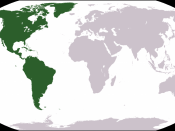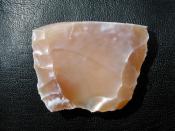For years people have thought that the Clovis people were the first to inhabit the Americas, but new archaeological evidence suggests that this theory is wrong. During the last ice age, as the sea level fell, a land bridge appeared between Asia and North America called Beringia. Animals and humans crossed from Asia to a continent where supposedly no human beings had lived before. When the ice melted and the sea level rose again, American continents were now cut off from the rest of the world leaving diverse civilizations to develop, greatly influenced by their natural surroundings. The Clovis people (named after a discovery camps near Clovis) were the group that came down from Beringia and, until recently, have been thought of as the first people to enter the Americas. Archaeologists have found their distinctive artifacts all over North America. They settled in the New World by pouring down from Alaska through the 1000-mile wide, ice-free land bridge.
It was nearly impassable for a century or more with little game or edible vegetation. After crossing this land bridge, they then split into smaller groups and developed new cultures as they went. Eventually, according to the theory, these people traveled south in search of a warmer climate populating one third of North America and all of South America. Along the way, they started adapting their hunting lifestyles for a more generalized hunting and collecting strategy. Because of accumulating evidence, a new theory called pre-Clovis was developed.
The reason why the pre-Clovis theory is not totally accepted is because, until recently, none of the archaeological sites in North America predated 11,200 BC. There were actually hundreds of sites that have been dated as older than the 11,200-year-old Clovis sites, including Calico in California. But each time, outside experts claimed that the...


